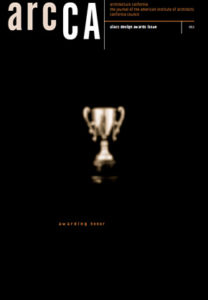
If you have been unsuccessful in your attempts to win a design award for your work, you might reasonably conclude that the projects that do get chosen to receive awards are selected either as a result of a worldwide conspiracy mounted against you and your firm, or, worse yet, pre-determined even before anyone sends in their entry fees. Having participated numerous times as a juror, a recipient, and more recently as an observer of a number of design awards programs, I find myself in a position to dispel the fears of bias, conspiracies, and fate and replace them with some common sense about how to submit your work.
Excellence
First, the bad news. Generally, only great design work wins design awards. If your project’s primary asset is energy conservation, submit it to an energy awards program unless it also has spectacular architectural design, then submit it to both. Design jurors take their responsibility very seriously and are extremely careful in their selections to ensure that every awarded project exhibits an extraordinary level of design excellence. Jurors are as rigorous in their selection process as they are in their own design work. In fact, they often view their selection as a reflection on their own standards and reputations, which, of course, no one takes lightly.
Strength
Don’t worry about the jury composition; again, good work wins awards. Poor work does not. Submitting work that you think looks like something a particular juror might appreciate should not be your motivation. In fact, issues of particular styles, languages, and forms almost never get discussed, because the focus of deliberations is typically more fundamental than that. Instead, urban design/site planning/social innovation, plan/section ingenuity, and technological/craft issues tend to dominate the discourse. Therefore, submit work because you feel it is strong, and present it so the jury can recognize that.
Participation
Have someone from the project’s design team participate in writing and assembling the submission. While there are many talented marketing and business development people in firms, design awards are given by a jury of designers, and your presentation should be crafted to speak to that audience on a very professional level. Be sure to be generous in crediting all parties who participated in helping realize the project. And follow all the rules. Obvious oversights, such as the firm name being visible on an image, have eliminated many submittals from even being considered.
Clarity
Provide the jury with all the basic visual information they need to understand the project. This sounds obvious, but many submittals create a huge challenge for the jurors to figure out what it is they are supposed to evaluate. For instance, if the project is an addition to an existing place or structure, show this clearly with before and after photographs or simple clear diagrams. In last year’s AIACC Design Awards, there was only one submittal that used graphic parti diagrams to explain the schemes intentions. Assume nothing. In fact, test your images on someone who doesn’t know the project and say nothing. This is how the jury gets their first look.
Simplicity
Write simply or clearly without hyperbole. I realize this is something that doesn’t come naturally to us, but we need to improve our abilities in this area. After 200 or so project statements are read to the jury with each submittal touting its own design as timeless, innovative, forward looking, contextual, and client responsive, the jurors long for simple, informative statements that compliment the images they are looking at while these words are read. Think about the forces that shaped the project that are not visible in the images, and use this opportunity to reveal them. These forces could include anything from cost constraints to community process.
Images
Use photographs that actually show the project in use. Since the jurors can’t visit the projects, this is a great way to show them that your theories work in practice and also a way to reveal aspects of the projects that are only evident when people occupy the spaces. A staircase that gets used as an impromptu amphitheatre at an elementary school, a translucent wall that is animated by people moving behind it, a view out to a landscaped vignette that is only visible once someone sits down are examples of the types of information that jurors will not understand without images to support these designed experiences.
Resubmit
Always resubmit. Every jury is different and every pool of entries is different. 350 entries that only include 15 affordable housing projects make a jury hunger for that building type and review those submittals extra carefully. Since you can’t control the mix, resubmitting a project two or three times is a good strategy. You’ve already done all the work to put the presentation together, so recoup some of the investment by using it more than once: submit it at local, state and national levels in AIA, industry specific, government, and magazine awards programs. Let the rejections be like water off a duck’s back. Keep doing what you think is the best work you can do, and keep submitting it.
Published 3rd Quarter 2007, in arcCA 07.3, “Comparing Awards.” First published in arcCA 01.1, “Awarding Honor,” first quarter 2001.





